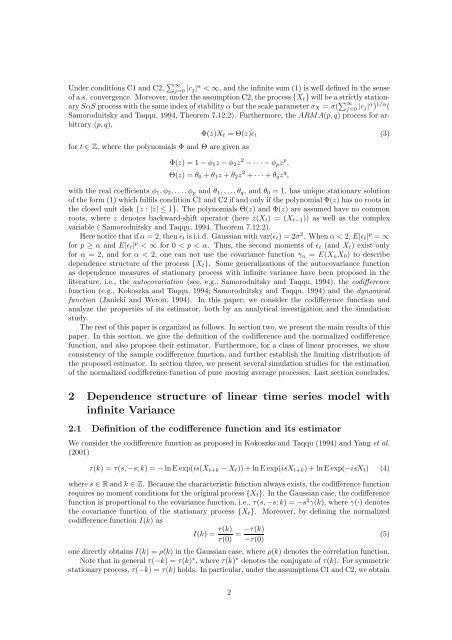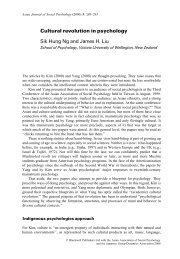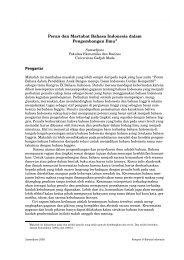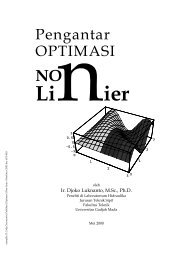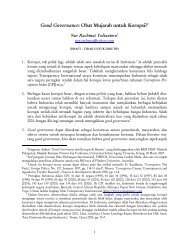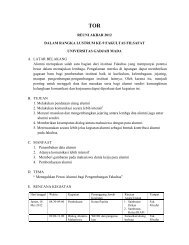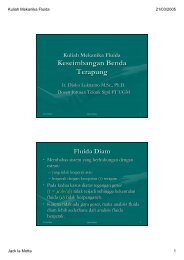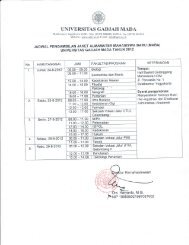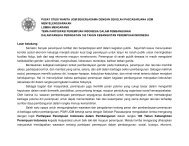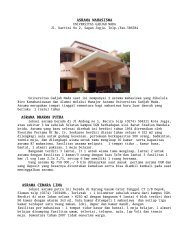Estimating the Codifference Function of Linear Time Series Models ...
Estimating the Codifference Function of Linear Time Series Models ...
Estimating the Codifference Function of Linear Time Series Models ...
You also want an ePaper? Increase the reach of your titles
YUMPU automatically turns print PDFs into web optimized ePapers that Google loves.
Under conditions C1 and C2, ∑ ∞<br />
j=0 |c j| α < ∞, and <strong>the</strong> infinite sum (1) is well defined in <strong>the</strong> sense<br />
<strong>of</strong> a.s. convergence. Moreover, under <strong>the</strong> assumption C2, <strong>the</strong> process {X t } will be a strictly stationary<br />
SαS process with <strong>the</strong> same index <strong>of</strong> stability α but <strong>the</strong> scale parameter σ X = σ( ∑ ∞<br />
j=0 |c j| α ) 1/α (<br />
Samorodnitsky and Taqqu, 1994, Theorem 7.12.2). Fur<strong>the</strong>rmore, <strong>the</strong> ARMA(p, q) process for arbitrary<br />
(p, q),<br />
Φ(z)X t = Θ(z)ǫ t (3)<br />
for t ∈ Z, where <strong>the</strong> polynomials Φ and Θ are given as<br />
Φ(z) = 1 − φ 1 z − φ 2 z 2 − · · · − φ p z p ,<br />
Θ(z) = θ 0 + θ 1 z + θ 2 z 2 + · · · + θ q z q ,<br />
with <strong>the</strong> real coefficients φ 1 , φ 2 , . . . , φ p and θ 1 , . . .,θ q , and θ 0 = 1, has unique stationary solution<br />
<strong>of</strong> <strong>the</strong> form (1) which fulfils condition C1 and C2 if and only if <strong>the</strong> polynomial Φ(z) has no roots in<br />
<strong>the</strong> closed unit disk {z : |z| ≤ 1}. The polynomials Θ(z) and Φ(z) are assumed have no common<br />
roots, where z denotes backward-shift operator (here z(X t ) = (X t−1 )) as well as <strong>the</strong> complex<br />
variable ( Samorodnitsky and Taqqu, 1994, Theorem 7.12.2).<br />
Here notice that if α = 2, <strong>the</strong>n ǫ t is i.i.d. Gaussian with var(ǫ t ) = 2σ 2 . When α < 2, E|ǫ t | p = ∞<br />
for p ≥ α and E|ǫ t | p < ∞ for 0 < p < α. Thus, <strong>the</strong> second moments <strong>of</strong> ǫ t (and X t ) exist only<br />
for α = 2, and for α < 2, one can not use <strong>the</strong> covariance function γ n = E(X n X 0 ) to describe<br />
dependence structure <strong>of</strong> <strong>the</strong> process {X t }. Some generalizations <strong>of</strong> <strong>the</strong> autocovariance function<br />
as dependence measures <strong>of</strong> stationary process with infinite variance have been proposed in <strong>the</strong><br />
literature, i.e., <strong>the</strong> autocovariation (see, e.g., Samorodnitsky and Taqqu, 1994), <strong>the</strong> codifference<br />
function (e.g., Kokoszka and Taqqu, 1994; Samorodnitsky and Taqqu, 1994) and <strong>the</strong> dynamical<br />
function (Janicki and Weron, 1994). In this paper, we consider <strong>the</strong> codifference function and<br />
analyze <strong>the</strong> properties <strong>of</strong> its estimator, both by an analytical investigation and <strong>the</strong> simulation<br />
study.<br />
The rest <strong>of</strong> this paper is organized as follows. In section two, we present <strong>the</strong> main results <strong>of</strong> this<br />
paper. In this section, we give <strong>the</strong> definition <strong>of</strong> <strong>the</strong> codifference and <strong>the</strong> normalized codifference<br />
function, and also propose <strong>the</strong>ir estimator. Fur<strong>the</strong>rmore, for a class <strong>of</strong> linear processes, we show<br />
consistency <strong>of</strong> <strong>the</strong> sample codifference function, and fur<strong>the</strong>r establish <strong>the</strong> limiting distribution <strong>of</strong><br />
<strong>the</strong> proposed estimator. In section three, we present several simulation studies for <strong>the</strong> estimation<br />
<strong>of</strong> <strong>the</strong> normalized codifference function <strong>of</strong> pure moving average processes. Last section concludes.<br />
2 Dependence structure <strong>of</strong> linear time series model with<br />
infinite Variance<br />
2.1 Definition <strong>of</strong> <strong>the</strong> codifference function and its estimator<br />
We consider <strong>the</strong> codifference function as proposed in Kokoszka and Taqqu (1994) and Yang et al.<br />
(2001)<br />
τ(k) = τ(s, −s; k) = − ln E exp(is(X t+k − X t )) + ln E exp(isX t+k ) + ln E exp(−isX t ) (4)<br />
where s ∈ R and k ∈ Z. Because <strong>the</strong> characteristic function always exists, <strong>the</strong> codifference function<br />
requires no moment conditions for <strong>the</strong> original process {X t }. In <strong>the</strong> Gaussian case, <strong>the</strong> codifference<br />
function is proportional to <strong>the</strong> covariance function, i.e., τ(s, −s; k) = −s 2 γ(k), where γ(·) denotes<br />
<strong>the</strong> covariance function <strong>of</strong> <strong>the</strong> stationary process {X t }. Moreover, by defining <strong>the</strong> normalized<br />
codifference function I(k) as<br />
I(k) = τ(k)<br />
τ(0) = −τ(k)<br />
(5)<br />
−τ(0)<br />
one directly obtains I(k) = ρ(k) in <strong>the</strong> Gaussian case, where ρ(k) denotes <strong>the</strong> correlation function.<br />
Note that in general τ(−k) = τ(k) ∗ , where τ(k) ∗ denotes <strong>the</strong> conjugate <strong>of</strong> τ(k). For symmetric<br />
stationary process, τ(−k) = τ(k) holds. In particular, under <strong>the</strong> assumptions C1 and C2, we obtain<br />
2


